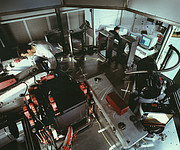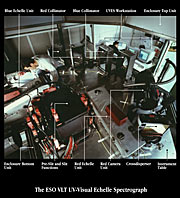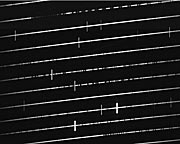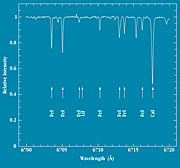Press Release
The UVES Spectrograph Sees the Sun
New VLT Instrument Nearing Completion
18 November 1998
The third astronomical instrument to be mounted on the ESO's Very Large Telescope (VLT) - following FORS1 and ISAAC - is now nearing completion at the ESO Headquarters in Garching (Bavaria, Germany). Housed in a modernistic building, some 15 km north of Munich, this is a major science and technology centre with advanced laboratory facilities.
The VLT UV-Visual Echelle Spectrograph (UVES) is a complex assembly of advanced opto-mechanical systems and the associated control electronics and motors. The entire system is remotely computer controlled and will perform a spectral analysis of the light from celestial objects that is collected by the giant telescope mirrors. The design of UVES was begun in 1992 and its realization involved scientists and engineers at ESO and the Observatory of Trieste (Italy), as well as companies from all over Europe.
Spectroscopic observations serve to separate the light from an object, be it a flame or a lamp in the laboratory, a star or a galaxy observed through a telescope, into its constituent colours - blue on one side, red on the other. The resulting band of coloured light is called a spectrum . A glass prism produces this effect; in nature small raindrops in the air may cause a rainbow to be seen in the sky.
Various types of spectrographs are used in many contexts, e.g. for environmental studies or process control. They allow researchers to perform a detailed analysis of light emitted or absorbed by test specimens. As every element has its own unique spectral "fingerprint", this technique allows for instance to detect minute traces of pollutants in material samples.
Astronomical spectrographs like UVES are used to probe celestial objects that are distant in space and time. This new instrument will be mounted on the second 8.2-metre VLT Unit telescope (UT2) in the middle of 1999. The light-efficient design of UVES, when combined with the great light-gathering capability of the UT2 will provide a unique facility for many front-line astronomical observations.
A UVES spectrum of the Sun
ESO Press Photo eso9854c shows part of a test spectrum of the Sun, taken by UVES in the Laboratory in Garching on October 19, 1998. The bright (nearly) horizontal lines correspond to adjacent, small wavelength ranges of the solar spectrum. Within these, many vertical dark lines indicate the presence of certain elements in the solar atmosphere, for instance gaseous hydrogen or iron. From the line shapes and their depths, it is possible to determine the temperature, pressure and chemical abundances of this gas. Small shifts in wavelength of such lines, when measured in other stars, indicate velocity changes due to the Doppler effect that may be caused by invisible planets circling the observed star. In ESO Press Photo eso9854d is shown a tracing of a small part of this test spectrum. The dips correspond to absorption caused by particular elements in the solar atmosphere, as indicated.
One of the first "observations" with UVES in Garching consisted in registering a small part of the solar spectrum. For this purpose, an optical fibre was attached to the spectrograph's entry slit (to which the light from celestial objects will later be directed) and simply pointed towards a roof window in the laboratory. A part of the solar spectrum recorded during a short exposure is seen in ESO Press Photo eso9854c. A tracing of a small wavelength region is shown in ESO Press Photo eso9854d. These data are used to test and optimize the performance of UVES before it will be installed at the telescope.
Future observations with UVES
When it becomes fully operational at the UT2 next year, UVES will be used to tackle some of the most exciting and elusive problems of modern astrophysics.
For example, it will measure the gas which filled cosmic space in the early phases of the Universe when it was just one tenth of its present age. It will study the motion of gas and stars in energetic nuclei of galaxies, trying to reveal the properties of the gigantic black holes that are thought to reside there. It will map the chemical composition of stars - both in the Milky Way and in other galaxies - providing systematic data which can give us new insights into the nuclear processes that take place deep inside the stars.
Video News Reel with UVES sequences available
ESO has produced ESO Video News Reel No. 2 with sequences illustrating the current work around UVES. It includes interviews with two of the involved scientists, and is accompanied by detailed, written information, including a shot list and suggested narration. The sound track contains original sound, only.
An extract of ESO Video News Reel No. 2 is available as ESO Press Video eso9854, as MPEG (Video and Video+Audio) and in a RealMedia-version that requires the RealPlayer software.
ESO Video News Reels are produced specifically for broadcast use . They are available on VHS, Betacam SP and MII. The footage is free to air ("Conditions for Use of ESO Video Footage" are enclosed with the video tapes), if credit is given to the European Southern Observatory (© 1998). The tapes are only available on request from the ESO EPR Department.
More information
Technical Information:
- This image was obtained by combining 45 1-min exposures, taken with the telescope randomly offset by small amounts in between ("jittering") to allow subtraction of the bright sky emission at this wavelength. The seeing was 0.5 arcsec and the limiting magnitude is around Ks = 22. The field measures 2.5 x 2.5 arcmin with N at the top and E to the left.
About the Release
| Release No.: | eso9854 |
| Legacy ID: | Photo 44a-d/98 |
| Name: | Spectrum, Sun, UVES |
| Type: | Solar System : Star Unspecified : Technology : Observatory : Instrument |
| Facility: | Very Large Telescope |
| Instruments: | UVES |
Our use of Cookies
We use cookies that are essential for accessing our websites and using our services. We also use cookies to analyse, measure and improve our websites’ performance, to enable content sharing via social media and to display media content hosted on third-party platforms.
ESO Cookies Policy
The European Organisation for Astronomical Research in the Southern Hemisphere (ESO) is the pre-eminent intergovernmental science and technology organisation in astronomy. It carries out an ambitious programme focused on the design, construction and operation of powerful ground-based observing facilities for astronomy.
This Cookies Policy is intended to provide clarity by outlining the cookies used on the ESO public websites, their functions, the options you have for controlling them, and the ways you can contact us for additional details.
What are cookies?
Cookies are small pieces of data stored on your device by websites you visit. They serve various purposes, such as remembering login credentials and preferences and enhance your browsing experience.
Categories of cookies we use
Essential cookies (always active): These cookies are strictly necessary for the proper functioning of our website. Without these cookies, the website cannot operate correctly, and certain services, such as logging in or accessing secure areas, may not be available; because they are essential for the website’s operation, they cannot be disabled.
Functional Cookies: These cookies enhance your browsing experience by enabling additional features and personalization, such as remembering your preferences and settings. While not strictly necessary for the website to function, they improve usability and convenience; these cookies are only placed if you provide your consent.
Analytics cookies: These cookies collect information about how visitors interact with our website, such as which pages are visited most often and how users navigate the site. This data helps us improve website performance, optimize content, and enhance the user experience; these cookies are only placed if you provide your consent. We use the following analytics cookies.
Matomo Cookies:
This website uses Matomo (formerly Piwik), an open source software which enables the statistical analysis of website visits. Matomo uses cookies (text files) which are saved on your computer and which allow us to analyze how you use our website. The website user information generated by the cookies will only be saved on the servers of our IT Department. We use this information to analyze www.eso.org visits and to prepare reports on website activities. These data will not be disclosed to third parties.
On behalf of ESO, Matomo will use this information for the purpose of evaluating your use of the website, compiling reports on website activity and providing other services relating to website activity and internet usage.
Matomo cookies settings:
Additional Third-party cookies on ESO websites: some of our pages display content from external providers, e.g. YouTube.
Such third-party services are outside of ESO control and may, at any time, change their terms of service, use of cookies, etc.
YouTube: Some videos on the ESO website are embedded from ESO’s official YouTube channel. We have enabled YouTube’s privacy-enhanced mode, meaning that no cookies are set unless the user actively clicks on the video to play it. Additionally, in this mode, YouTube does not store any personally identifiable cookie data for embedded video playbacks. For more details, please refer to YouTube’s embedding videos information page.
Cookies can also be classified based on the following elements.
Regarding the domain, there are:
- First-party cookies, set by the website you are currently visiting. They are stored by the same domain that you are browsing and are used to enhance your experience on that site;
- Third-party cookies, set by a domain other than the one you are currently visiting.
As for their duration, cookies can be:
- Browser-session cookies, which are deleted when the user closes the browser;
- Stored cookies, which stay on the user's device for a predetermined period of time.
How to manage cookies
Cookie settings: You can modify your cookie choices for the ESO webpages at any time by clicking on the link Cookie settings at the bottom of any page.
In your browser: If you wish to delete cookies or instruct your browser to delete or block cookies by default, please visit the help pages of your browser:
Please be aware that if you delete or decline cookies, certain functionalities of our website may be not be available and your browsing experience may be affected.
You can set most browsers to prevent any cookies being placed on your device, but you may then have to manually adjust some preferences every time you visit a site/page. And some services and functionalities may not work properly at all (e.g. profile logging-in, shop check out).
Updates to the ESO Cookies Policy
The ESO Cookies Policy may be subject to future updates, which will be made available on this page.
Additional information
For any queries related to cookies, please contact: pdprATesoDOTorg.
As ESO public webpages are managed by our Department of Communication, your questions will be dealt with the support of the said Department.





